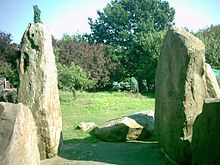Chestnuts long barrow

View looking east through the burial chamber
|
|
| Location | Addington, Kent |
|---|---|
| Coordinates | 51°18′28″N 0°22′10″E / 51.307655°N 0.369557°E |
| Type | Long barrow |
The Chestnuts Long Barrow, also known as Stony or Long Warren, is a chambered long barrow located near to the village of Addington in the southeastern English county of Kent. Constructed circa 4000 BCE, during the Early Neolithic period of British prehistory, today it survives only in a ruined state.
Archaeologists have established that the monument was built by pastoralist communities shortly after the introduction of agriculture to Britain from continental Europe. Although representing part of an architectural tradition of "barrow", or tumulus, building that was widespread across Neolithic Europe, the Chestnuts Long Barrow belong to a localised regional variant of barrows produced in the vicinity of the River Medway, now known as the Medway Megaliths. Of these, it lies near to both Addington Long Barrow and Coldrum Long Barrow on the western side of the river. Three further surviving long barrows, Kit's Coty House, the Little Kit's Coty House, and the Coffin Stone, are located on the Medway's eastern side.
The location selected for the barrow had witnessed inhabitation during the preceding Mesolithic period, as evidenced by a nearby hearth and scatters of knapped flint tools. Built out of earth and local sarsen megaliths, the long barrow consisted of a sub-rectangular earthen tumulus. Within the eastern end of the tumulus was a stone chamber, into which human remains were deposited, alongside sherds of pottery vessels. The barrow was still standing in the 4th century CE, when a small Romano-British hut was erected next to it. Around the 12th or 13th century, the chamber was systematically turned over, perhaps by treasure hunters or iconoclastic Christians. Pits were dug under the stones and the barrow was shovelled away. This caused the chamber to collapse, sealing medieval sherds under the stones. The ruin attracted the interest of antiquarians in the 18th and 19th centuries, while archaeological excavation took place in 1957, followed by limited reconstruction. The site is located on private land; visits can be organised by appointment with the land owner.
...
Wikipedia

